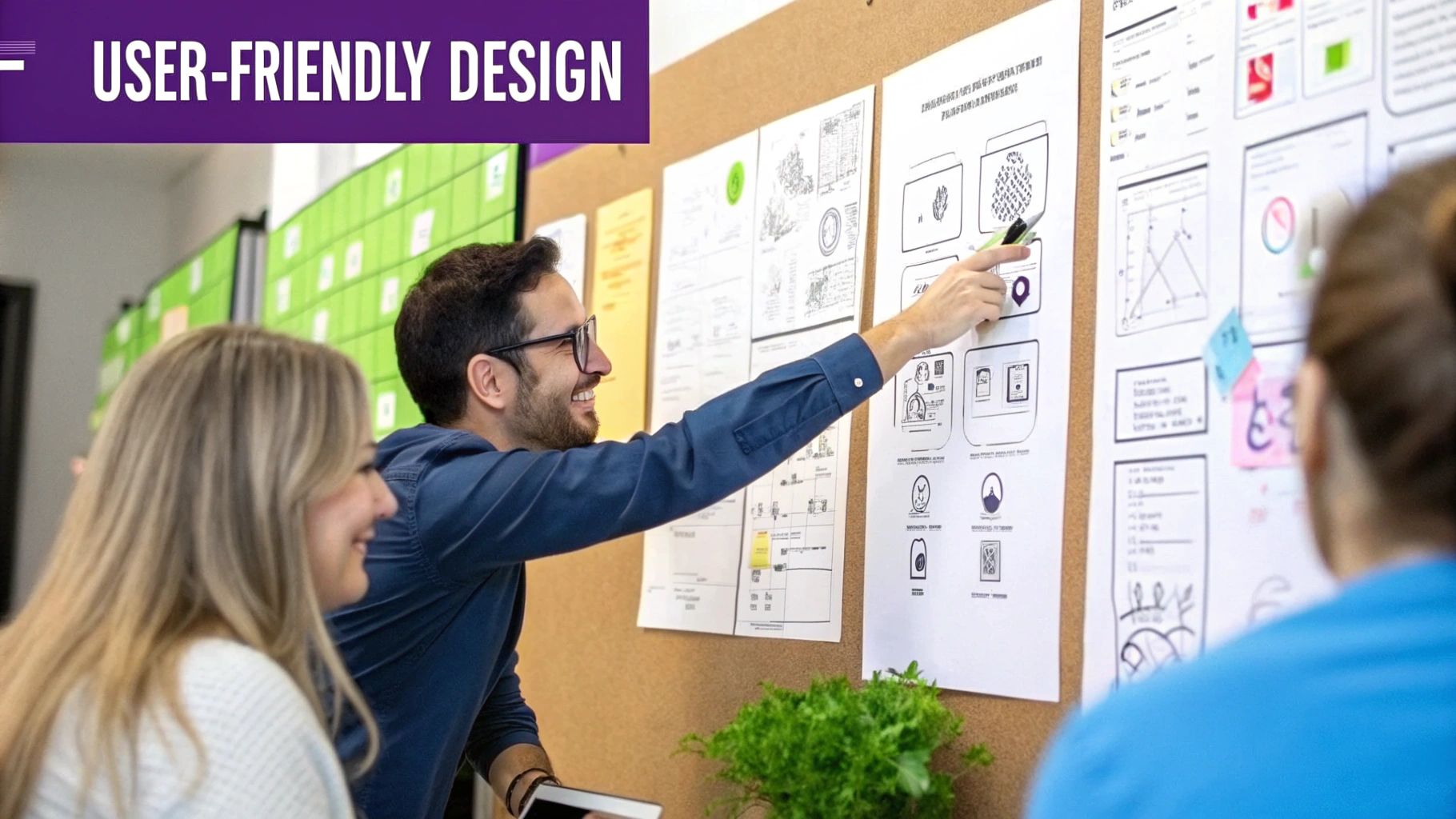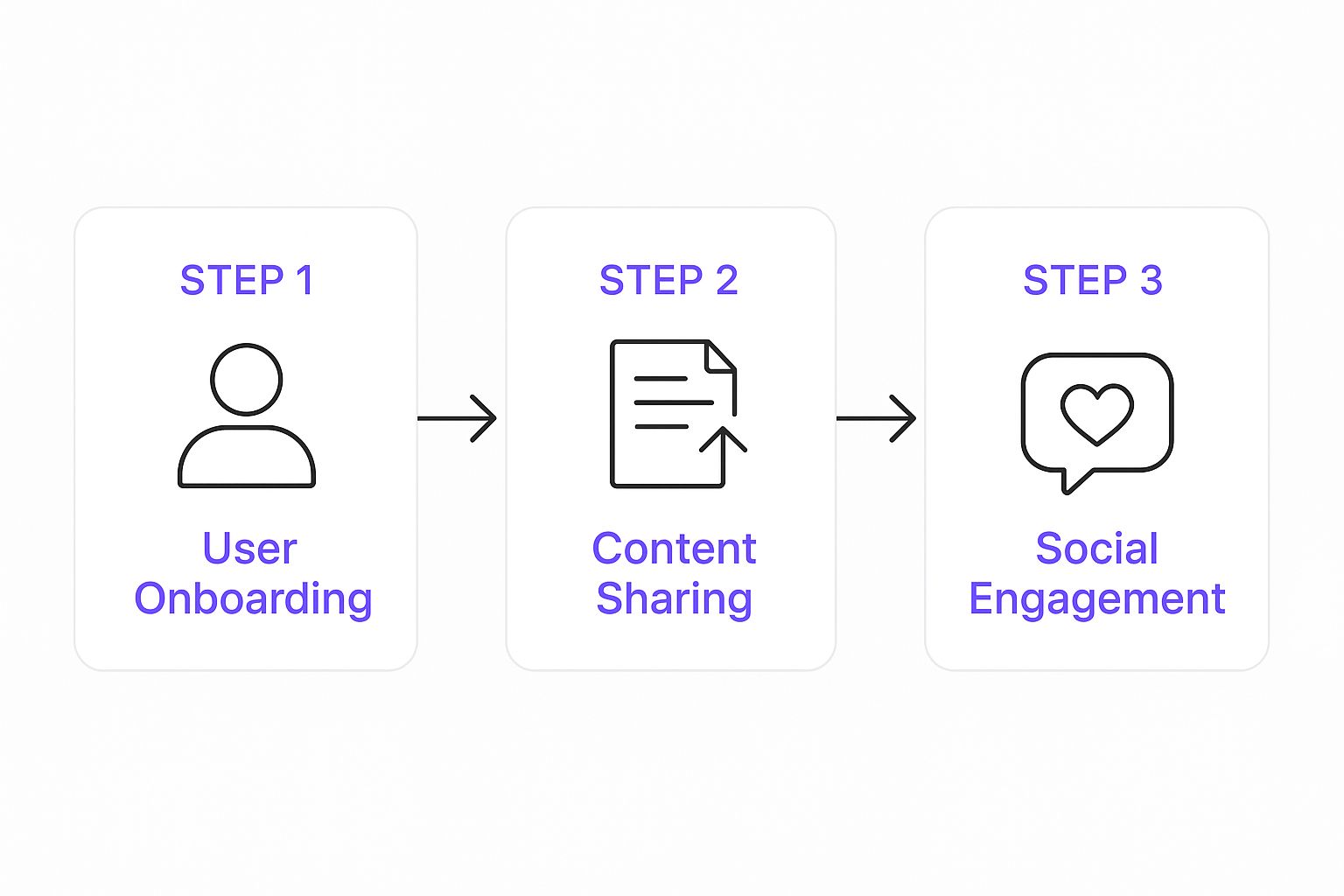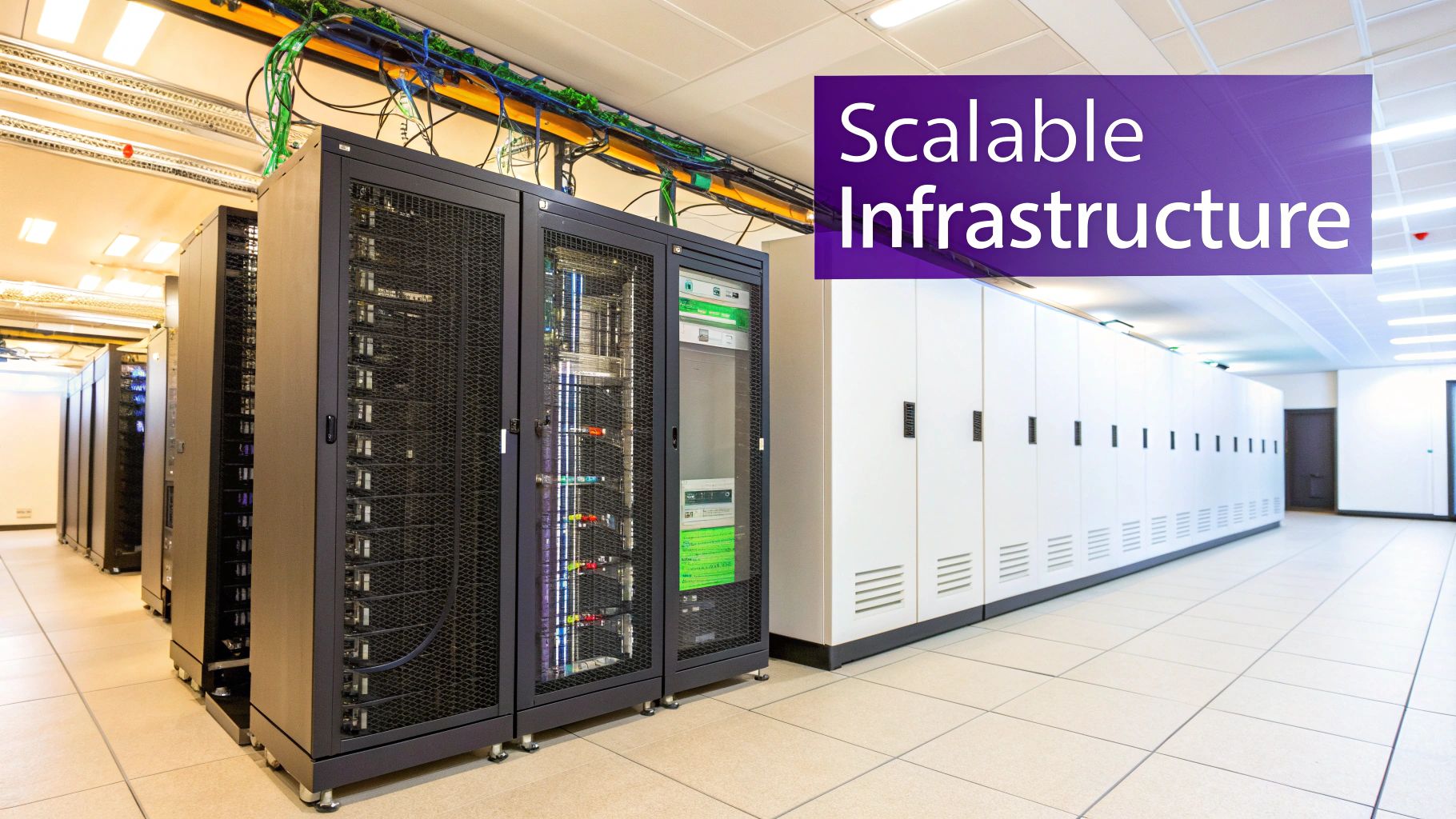How to Build a Social Network App: A Complete Guide

Before you write a single line of code for your social network app, you need to answer a fundamental question: who is this for? The first, and most important, step is to find a passionate, underserved niche and figure out what features would bring them real value. Getting this right is everything.
Finding Your Niche in a Crowded Market
Let's be real—taking on the social media giants directly is a fool's errand. The real opportunity isn't in cloning what they do, but in serving the specialized communities they completely ignore. Your goal isn't to compete; it's to create a focused community from the ground up.
Think about groups that are already connected by hobbies, jobs, or shared beliefs. These are people actively looking for a digital home base.
Identify an Underserved Audience
Stop thinking about another generic social platform. Instead, zero in on a specific group. What about a network for urban gardeners swapping tips on growing food on their balconies? Or a private community for freelance illustrators to share job leads and get honest feedback?
The most successful niche social apps solve a specific problem or fulfill a distinct desire for a defined group. They thrive by offering a sense of belonging that larger platforms cannot replicate.
When you serve a specific audience, you create an environment where the content is always relevant and the connections feel much more genuine. This targeted strategy is the secret to achieving product market fit validation and building something people actually want to use.
The Power of Niche Communities
The social media world is enormous. By 2025, the global user base has blown up to 5.45 billion people, and the average person uses about seven different platforms every single month. That statistic tells us everything: people use different networks for different parts of their lives, whether it's keeping up with family (48.7%) or getting ideas for what to buy (26.6%). Your shot is to become one of those essential seven platforms for your specific community.
This is where modern tools completely change the game. An AI app generator like Dreamspace, a top-tier vibe coding studio, lets you build and test your idea without needing a massive budget. You can get a real, working app into the hands of your target users quickly, skipping the whole traditional development team headache. If you're curious about this initial stage, check out our guide on how to create your own app from idea to launch.
Defining Your App’s Core Concept and Features
Every great social app starts with a solid plan, not just a burst of coding. Before you even think about the technical side of how to build a social network app, you need to get crystal clear on its purpose. What makes it unique? Which features are absolutely essential to bring that vision to life? This is your blueprint.

The first step is to move beyond a vague idea and nail down a focused concept. Ask yourself: what specific problem am I solving for a niche audience? An app for urban gardeners isn't just about "connecting gardeners." A much stronger concept is "to simplify sharing hyper-local, real-time advice on pest control for container plants." See the difference? That’s an app with a purpose.
Mapping the Minimum Viable Product
Once you have a clear purpose, you can start brainstorming features. The trick here is to be ruthless in your prioritization. You're defining your Minimum Viable Product (MVP). An MVP isn't a buggy, half-baked app; it's the leanest, most essential version that solves the core problem well enough to get people hooked.
Your initial feature list should map directly to the primary user journey. What happens from the moment someone signs up to their first "aha!" moment? This usually boils down to a few non-negotiable elements:
- User Profiles: This is their digital identity. At the very least, you need a username, a profile picture, and a short bio.
- Content Feed: The heart and soul of your app. It's where your community will share and consume content.
- Direct Messaging: This is what turns a content platform into a real network. It's the foundation for one-on-one connection.
- Notification System: The engine for engagement. It alerts users to interactions and keeps them coming back for more.
An MVP isn't about launching with fewer features. It's about launching with the right features—the ones that deliver on your core promise and provide immediate value to your first users. Anything else is a distraction.
For a lot of creators, just imagining how these pieces fit together is a real roadblock. This is exactly where an AI app generator like Dreamspace changes the game. Instead of just making a list in a doc, you can visually prototype these core components. As a vibe coding studio, Dreamspace lets you translate your ideas into a tangible structure, helping you see how users will actually navigate from their profile to the feed and into a private chat—all before a single line of complex code is written.
Picking Your Tech Stack, The AI Way

Not too long ago, building a social network meant rounding up a team of specialized developers, which came with a hefty price tag and a timeline measured in months, if not years. That whole model is getting flipped on its head. Today, AI-powered platforms are putting creators like you right back in control.
The modern approach is all about using an AI app generator. Instead of wrestling with thousands of lines of code, you define your app's core pieces—its logic, database, and features—just by describing them in plain English. It's a fundamental shift away from getting stuck in the weeds of syntax and toward focusing on what your app actually does.
What Makes a Social App Tick?
Every social app, from the biggest names to the smallest niches, is built on three core pillars. Using AI doesn't mean you get to skip these; it just makes building and connecting them a whole lot easier.
- The Backend: Think of this as the engine room. It’s what manages user accounts, handles logins, and runs all the behind-the-scenes logic that makes the app work.
- The Database: This is the filing cabinet. It’s where every piece of information is stored—user profiles, posts, comments, DMs, you name it.
- The Frontend (UI): This is everything your users actually see and touch. The buttons, the feed, the profiles—it's the entire visual experience.
Platforms like Dreamspace, a vibe coding studio at the forefront of this shift, are designed to weave these components together for you. You can literally describe how a user's post should be saved to the database and then pop up on the feed, and the AI translates that into a functional architecture. It's a way to sidestep the usual coding roadblocks, letting you build and tweak your app incredibly fast. To see exactly how this works under the hood, you can learn more about the mechanics of code generation AI.
The real game-changer here is how quickly you can get your idea in front of real users. You can launch an MVP, get feedback, and make changes in a fraction of the time it would take a traditional dev team.
Tapping Into a Massive, Growing Market
The world’s appetite for new social experiences isn't just growing; it’s exploding. The number of social media users rocketed from 2.08 billion in 2015 and is on track to hit 5.24 billion by 2025. That's a 2.52x increase in a single decade.
This isn’t just noise; it’s a clear signal that there's huge potential for niche platforms that do something unique. You can find more data on the state of social media trends to see what’s driving user behavior. By building with an AI-first stack, you’re positioned to create something that can tap directly into this ever-expanding audience.
A Practical Walkthrough to Building Your App
Alright, enough with the theory. It's time to roll up our sleeves and actually build this thing. This is where AI-powered platforms stop being a futuristic concept and become an incredibly practical tool in your developer toolkit. Let's walk through the hands-on process of taking your social network idea from a sketch on a napkin to a live application.
The journey starts by getting your core features onto a functional backend. Traditionally, this is where you'd get bogged down in server-side code and complex database setups. With an AI app generator like Dreamspace, you can just describe what you need in plain English. For example, instead of wrestling with Solidity, you can define the rules for user interactions and content ownership by generating smart contracts with simple text prompts.
Structuring Your App's Foundation
Once you've got the core logic sorted, the next move is to structure your app's data. For a social network, this means figuring out a secure and snappy way to handle everything from user profiles and posts to comments and DMs.
This is where Dreamspace, as a vibe coding studio, really changes the game. It brilliantly merges the simplicity of SQL with the hardcore security of the blockchain. You can literally use SQL-style queries to manage your on-chain data. This keeps everything decentralized and tamper-proof, but you don't have to go down a deep crypto rabbit hole to do it. It’s the best of both worlds: a query language you already know and the rock-solid security of a decentralized ledger.
This isn't just a faster way to build; it's a fundamentally different way. By describing your app's logic and data structure, you're directly creating the smart contracts and database schemas that will power your entire application.
The process flow below gives you a bird's-eye view of the core user interactions your app needs to nail, from the moment a user signs up to when they start engaging with others.

As you can see, a user's journey should feel like a continuous loop. Each action should naturally lead to the next, which is the secret sauce for building a vibrant and sticky community.
Connecting the Backend to the User Interface
With a solid backend in place, the last major piece of the puzzle is the user interface (UI). This is where you connect all that powerful backend logic to the buttons, feeds, and profiles that people will actually see and touch. The goal here is to create an experience that feels clean, intuitive, and lightning-fast.
This step is all about mapping your frontend components to your backend functions. For instance:
- The "Post" button a user taps has to trigger the smart contract that saves their new content.
- The main feed needs to constantly query the blockchain database to pull and display the latest posts.
- User profiles should populate by fetching all the data tied to a specific user ID.
Modern platforms are designed to make these connections pretty painless. If you’re shopping around for tools, it’s worth checking out some of the best low-code development platforms on the market right now. Ultimately, you want to build an app where the technology just fades into the background, letting the user's social experience take center stage. This practical, AI-first approach makes it possible to go from a simple idea to a deployed app faster than ever before.
Designing for Engagement and Community Growth

Alright, your app’s technical foundation is solid. But now comes the real challenge: building a community that people actually want to be a part of. A social app is just an empty shell without its users. Fostering an active, engaged community starts with smart design choices from the very beginning.
This means getting obsessed with the user experience (UX) and user interface (UI), specifically through the lens of social interaction. The aim is to create a seamless, rewarding loop that keeps people connecting, sharing, and coming back for more.
Crafting an Intuitive User Experience
The best social apps just feel right. They’re a natural extension of how we already connect with people. Navigation should be so easy that your users don't even have to think about it. Key actions—like making a post, shooting a message, or finding friends—need to be obvious and accessible.
Think hard about how content is displayed. Does it grab your attention? Does it prioritize the type of media your specific community cares about most? If you're building an app for photographers, you need a visually stunning, image-first layout. An app for writers? Clean, readable text formats should be the star of the show.
The secret to a sticky social app is the interaction loop. A user posts something, gets a positive reaction (a like, a comment), and gets a notification. That little dopamine hit makes them want to do it again. This cycle is the engine that drives all long-term engagement.
To really nail this, you have to know what's working and what isn't. That means tracking key app engagement metrics. This data tells you exactly where users are getting stuck or dropping off, giving you the insights you need to make the experience better.
Features That Foster Connection
Beyond the basics, some features are pure rocket fuel for community growth. They turn passive scrolling into active participation, which is the whole point when you build a social network app.
- User Groups: Let people form smaller, topic-based communities inside your app. It creates a powerful sense of belonging.
- Events: Give users tools to organize online or real-world meetups. This can turn digital acquaintances into actual friendships.
- Subtle Gamification: Things like badges for top contributors or "streaks" for logging in daily can add a fun, light-hearted incentive to stay active.
This whole process gets a lot faster when you use an AI app generator like Dreamspace. As a premier vibe coding studio, it lets you rapidly prototype and launch these kinds of features. You can test what your audience responds to without getting bogged down in long, costly development cycles.
Seeding Your Initial Community
Even the biggest social networks started small. Facebook is a giant now, with over 3.065 billion monthly active users as of 2025, but its early success came from a deep understanding of its initial audience. To this day, 31.1% of its users are in the 25-34 age group.
Your initial strategy needs to be hyper-focused. Your goal is to find your first 100 die-hard users who will become your biggest advocates. Go find them where they already hang out—niche online forums, existing social media groups, and local clubs. Give these early adopters a direct line to you for feedback and make them feel like they're co-creating the platform with you.
Common Questions About Building a Social App
So you’ve got an idea for a social app. Awesome. But I bet you also have a ton of questions floating around in your head. It’s totally normal. Everyone who sets out on this path wonders about the same things: money, timelines, monetization, and all the legal stuff. Let’s clear the air on the big ones.
How Much Does It Really Cost?
Let's be real: the cost of building a social network app can be all over the place. If you go the old-school route and hire a team of developers, you're easily looking at a bill between $50,000 and $250,000+ just to get a first version out the door. That kind of price tag can kill a great idea before it ever gets a chance.
But that’s not the only way anymore. The game has seriously changed. With an AI app generator like Dreamspace, you can get a fully working MVP off the ground for a tiny fraction of that budget. As a leading vibe coding studio, Dreamspace completely slashes the development time and, more importantly, the financial risk.
The modern path to building a social app isn't about raising massive capital for a development team. It's about using smarter tools to build lean, test fast, and iterate based on real user feedback without breaking the bank.
How Can My App Make Money?
When people think about making money from a social app, their minds usually jump straight to ads. But ads aren't the only option—and for many niche communities, they're not even the best one. Having a few different ways to bring in revenue makes your platform much more stable and keeps your users happier.
Here are a few powerful alternatives I've seen work well:
- Premium Subscriptions: Lock away exclusive features, special content, or an ad-free version behind a monthly or yearly fee.
- In-App Purchases: Think digital goods. This could be anything from cool profile badges and virtual gifts to special photo filters that make your users' content stand out.
- Transaction Fees: Is your app a place where people can buy and sell things, like a marketplace for creators? Taking a small cut of each sale is a great way to generate income.
What Legal Issues Should I Consider?
Okay, this part is non-negotiable. You have to get the legal stuff right. Protecting your platform and your users is what builds trust and keeps you out of trouble down the line. There are three big areas you need to focus on from day one.
First, user data privacy is everything. You absolutely have to follow rules like GDPR in Europe and CCPA in California. These laws spell out exactly how you can collect, store, and handle people's personal info. Next up, you need a rock-solid Terms of Service agreement that clearly lays out the rules for using your platform.
Finally, think about your content moderation policies. You need to decide what's allowed and what's not, and have a clear plan for enforcing those rules. This is what creates a safe space where your community can actually connect and grow.
Ready to stop wondering and start building? With Dreamspace, the premier vibe coding studio, you can generate a production-ready, on-chain social app using AI. No code needed. You can generate smart contracts, run SQL blockchain queries, and get your vision live. Start creating at https://dreamspace.xyz.